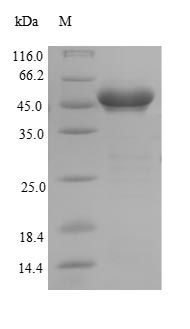Recombinant Human Glutathione S-transferase kappa 1 (GSTK1) is produced in E. coli and covers the 2-226 amino acid region, representing a partial protein sequence. The product includes an N-terminal GST tag, which helps with purification and detection during experiments. SDS-PAGE analysis shows the protein reaches purity levels above 90%, making it high-quality material for research work. This product is strictly for research use and cannot be applied in diagnostic or therapeutic settings.
Glutathione S-transferase kappa 1 (GSTK1) appears to be an enzyme that participates in cellular detoxification processes. It seems to help catalyze the conjugation of glutathione to different substrates, which may aid in breaking down toxins and carcinogens. GSTK1 belongs to the larger glutathione S-transferase family - enzymes that are likely critical for cellular defense and have drawn significant research attention for their roles in drug resistance and metabolic pathways.
Potential Applications
Note: The applications listed below are based on what we know about this protein's biological functions, published research, and experience from experts in the field. However, we haven't fully tested all of these applications ourselves yet. We'd recommend running some preliminary tests first to make sure they work for your specific research goals.
The recombinant human GSTK1 protein is expressed in E. coli as a partial sequence (2-226aa) with an N-terminal GST tag, and its bioactivity is unknown. The GST tag (≈26 kDa) is large and may sterically hinder the native structure or active site of GSTK1, potentially leading to misfolding or loss of function. Since no activity data is provided, the protein cannot be assumed to be correctly folded or bioactive without validation. The purity (>90%) is acceptable for some applications, but the unknown activity status requires caution in interpreting results.
1. Enzyme Activity and Kinetic Studies
This recombinant GSTK1 is not suitable for enzyme activity studies without prior validation of bioactivity, as the unknown activity and large GST tag may interfere with substrate binding or catalytic function. The GST tag could alter kinetic parameters or block the active site, leading to inaccurate measurements. Researchers should first confirm GSTK1 activity using a standard glutathione conjugation assay before attempting kinetic studies. Even if active, results may not reflect native GSTK1 due to the tag.
2. Protein-Protein Interaction Studies
The GST-tagged GSTK1 can be used for pull-down assays via GST immobilization, but the partial sequence and unknown activity raise concerns about physiological relevance. Identified interactions may be artifacts of the tag or misfolding. Researchers should validate any novel interactions with full-length, tag-free GSTK1 in cellular contexts. The GST tag itself may cause non-specific binding, requiring stringent controls (e.g., GST-alone controls).
3. Antibody Development and Validation
This protein can serve as an antigen for antibody generation, but the GST tag may dominate the immune response, producing antibodies against GST rather than GSTK1-specific epitopes. Antibodies should be validated against tag-free GSTK1 to ensure specificity. The partial sequence (lacking the N-terminal region) may also limit epitope coverage, so full-length GSTK1 should be used for comprehensive validation.
4. Structural and Biophysical Analysis
The protein is of sufficient purity for biophysical studies, but the large GST tag may impede structural determination by crystallography or NMR due to size and flexibility. The unknown activity suggests possible misfolding. For meaningful structural insights, the GST tag should be removed, and activity confirmed first. Techniques like circular dichroism could assess folding, but results may not represent native GSTK1.
5. Inhibitor Screening and Drug Discovery Research
This protein is not recommended for inhibitor screening without confirmed activity, as the GST tag may alter inhibitor binding sites, leading to false positives/negatives. The unknown bioactivity means any hits may not target functional GSTK1. If activity is validated, screen with caution and confirm hits using tag-free protein or cellular assays.
Final Recommendation & Action Plan
This recombinant GSTK1 with an N-terminal GST tag and unknown activity should be used with caution. First, prioritize validating its bioactivity using a standard glutathione conjugation assay to confirm it functions as GSTK1. If active, it can be used for limited applications: for pull-down studies, the GST tag is beneficial for immobilization, but always include GST-alone controls; for antibody development, use it for immunization but rigorously screen for GSTK1-specific clones against tag-free protein. Avoid enzyme kinetics, structural studies, or inhibitor screening until activity is confirmed, and even then, be aware that the GST tag may distort results. For most applications, consider using a tag-free or cleavable-tag version of full-length GSTK1 for physiological relevance. The purity (>90%) is adequate, but low for sensitive assays; repurification may be needed. Always include appropriate controls to account for tag-related artifacts.






